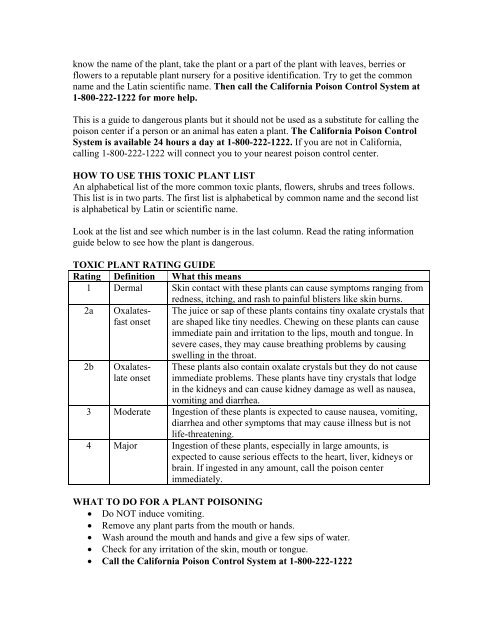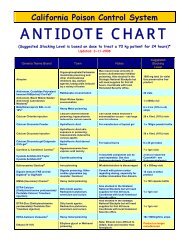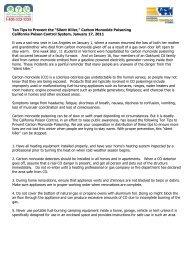KNOW YOUR PLANTS - California Poison Control System
KNOW YOUR PLANTS - California Poison Control System
KNOW YOUR PLANTS - California Poison Control System
Create successful ePaper yourself
Turn your PDF publications into a flip-book with our unique Google optimized e-Paper software.
know the name of the plant, take the plant or a part of the plant with leaves, berries or<br />
flowers to a reputable plant nursery for a positive identification. Try to get the common<br />
name and the Latin scientific name. Then call the <strong>California</strong> <strong>Poison</strong> <strong>Control</strong> <strong>System</strong> at<br />
1-800-222-1222 for more help.<br />
This is a guide to dangerous plants but it should not be used as a substitute for calling the<br />
poison center if a person or an animal has eaten a plant. The <strong>California</strong> <strong>Poison</strong> <strong>Control</strong><br />
<strong>System</strong> is available 24 hours a day at 1-800-222-1222. If you are not in <strong>California</strong>,<br />
calling 1-800-222-1222 will connect you to your nearest poison control center.<br />
HOW TO USE THIS TOXIC PLANT LIST<br />
An alphabetical list of the more common toxic plants, flowers, shrubs and trees follows.<br />
This list is in two parts. The first list is alphabetical by common name and the second list<br />
is alphabetical by Latin or scientific name.<br />
Look at the list and see which number is in the last column. Read the rating information<br />
guide below to see how the plant is dangerous.<br />
TOXIC PLANT RATING GUIDE<br />
Rating Definition What this means<br />
1 Dermal Skin contact with these plants can cause symptoms ranging from<br />
2a Oxalatesfast<br />
onset<br />
2b Oxalateslate<br />
onset<br />
redness, itching, and rash to painful blisters like skin burns.<br />
The juice or sap of these plants contains tiny oxalate crystals that<br />
are shaped like tiny needles. Chewing on these plants can cause<br />
immediate pain and irritation to the lips, mouth and tongue. In<br />
severe cases, they may cause breathing problems by causing<br />
swelling in the throat.<br />
These plants also contain oxalate crystals but they do not cause<br />
immediate problems. These plants have tiny crystals that lodge<br />
in the kidneys and can cause kidney damage as well as nausea,<br />
vomiting and diarrhea.<br />
3 Moderate Ingestion of these plants is expected to cause nausea, vomiting,<br />
diarrhea and other symptoms that may cause illness but is not<br />
life-threatening.<br />
4 Major Ingestion of these plants, especially in large amounts, is<br />
expected to cause serious effects to the heart, liver, kidneys or<br />
brain. If ingested in any amount, call the poison center<br />
immediately.<br />
WHAT TO DO FOR A PLANT POISONING<br />
• Do NOT induce vomiting.<br />
• Remove any plant parts from the mouth or hands.<br />
• Wash around the mouth and hands and give a few sips of water.<br />
• Check for any irritation of the skin, mouth or tongue.<br />
• Call the <strong>California</strong> <strong>Poison</strong> <strong>Control</strong> <strong>System</strong> at 1-800-222-1222








